Sometimes the sewing stars align to ensure success (and sometimes they don’t.) But this story is a success story, although it played out differently than I originally planned.

Having only 1.25 yards of this vintage wool restricted my options to either a simple sheath dress or a skirt. I opted for the sheath, with all good intentions of using the princess-lined pattern I had recently used for a pink dress in vintage Linton wool. In fact, one of the reasons I made the pink dress was to see if I would be able to successfully match plaids when I started on the red/green wool. (The weave of the pink Linton has a plaid woven into it, which I knew would be helpful to me in determining the pattern’s useability for a multi-color plaid.) Only one problem – when I laid out the pattern pieces on the Forstmann wool, I didn’t have enough fabric. I should have realized that the 7-panel princess dress would take more fabric than I had – and this time there was no making it work.
SO – I had to find another pattern. I have, over the years, made several sheath dresses using a newer Butterick pattern, but I really wanted to use a vintage pattern for this wool. Now, I have a lot of vintage patterns in my collection – and I went through every single one looking for the right sheath dress. At first I didn’t realize this pattern had the look I wanted.
I had originally purchased this pattern for that gorgeous shawl collared coat. But – BINGO – when I took another look, there was the perfect sheath looking right at me.
Although the pattern was not dated, I knew it was from the early 1960s. But of course, I thought it would be wonderful to know the year it first appeared. A lengthy search through old Vogue Pattern Magazines proved to be successful – not only successful, but timely. This pattern was included in the December 1962/January 1963 issue, and was the featured pattern for a Special Capsule Catalog included in the issue. Not only that, the caption read: “110 IDEAS TO START THE NEW YEAR IN VOGUE.” Yes, I thought, that’s what I want to do!

Of course, starting with a pattern I had not before used meant I had to make a muslin (toile) and fit it. That little effort took two days. But then I got started in earnest, cutting out the silk organza underlining and positioning it right where it needed to be on the fabric.
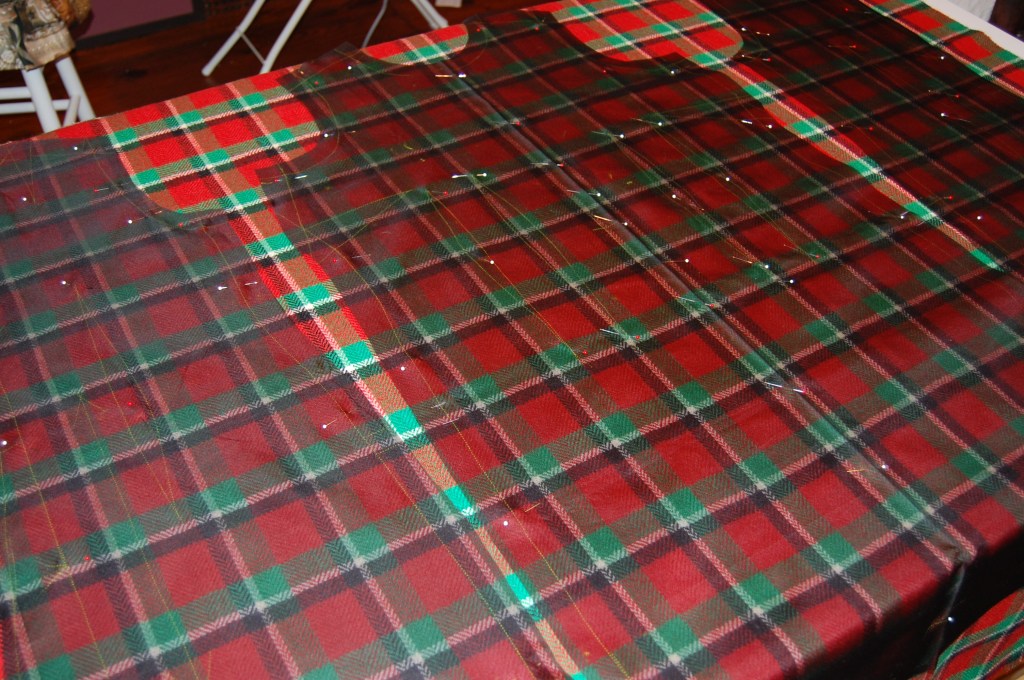
There were two important considerations for placing my silk organza underlining “templates” on the plaid: 1) the orientation of the plaid vertically and 2) the correct placement of the hemline on the grid of the plaid and making this placement work with the position of the waistline and neckline.
I thought the wider, darker part of each woven “block” on the plaid should be oriented to the bottom of the dress, which I believe is apparent above.
I find, when working with plaid, it is very important to have the hemline determined before you cut out your fabric. Visually it is more appealing if the hem does not cut a block of the plaid directly in half or, especially with smaller plaids, end right at the edge of a block. I think it looks better if there is a bit of a “float” around the bottom of the dress to anchor the bottommost blocks. (Larger plaids have their own considerations. Look at the art on the pattern envelope above to observe this.)
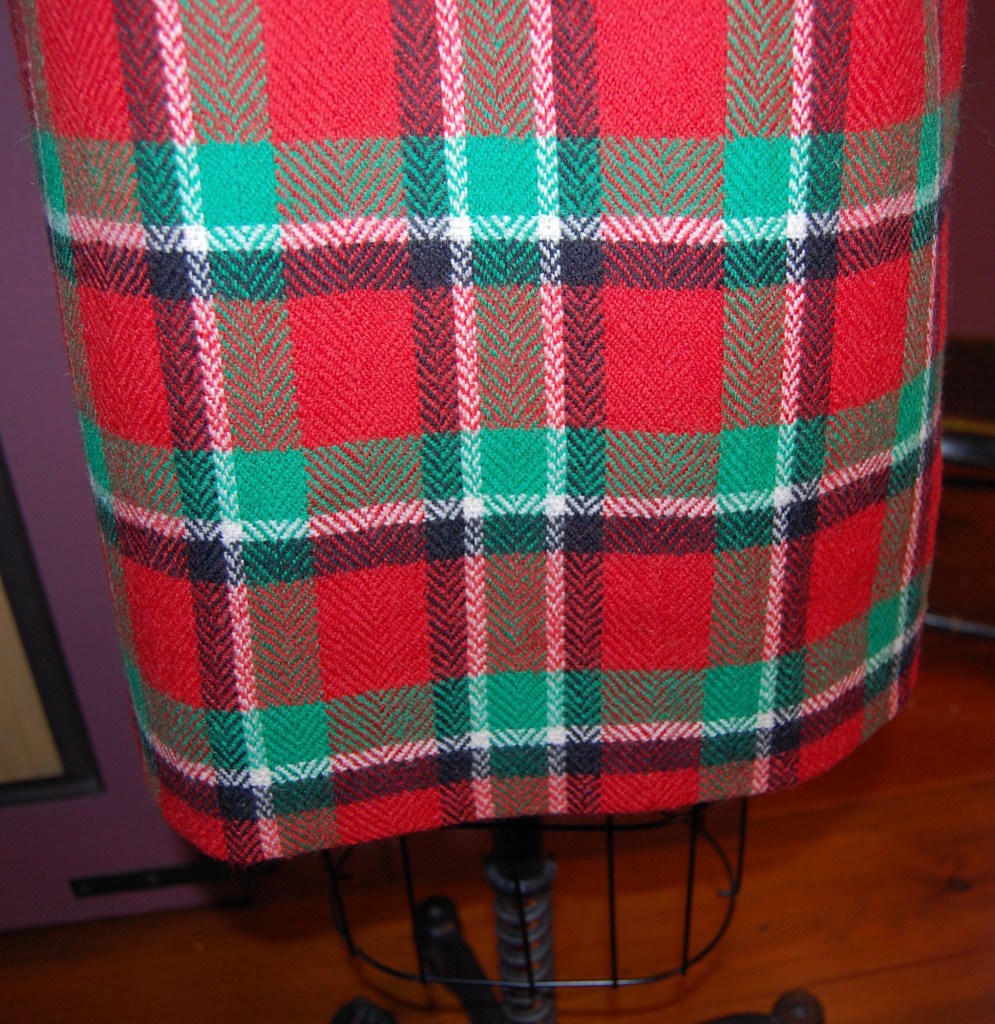
One of the design features of this dress is the kick pleat, which has its origin in the back seam starting at the bottom of the zipper. I wasn’t sure how I was going to work the lining around this, but I also thought I could probably figure it out.

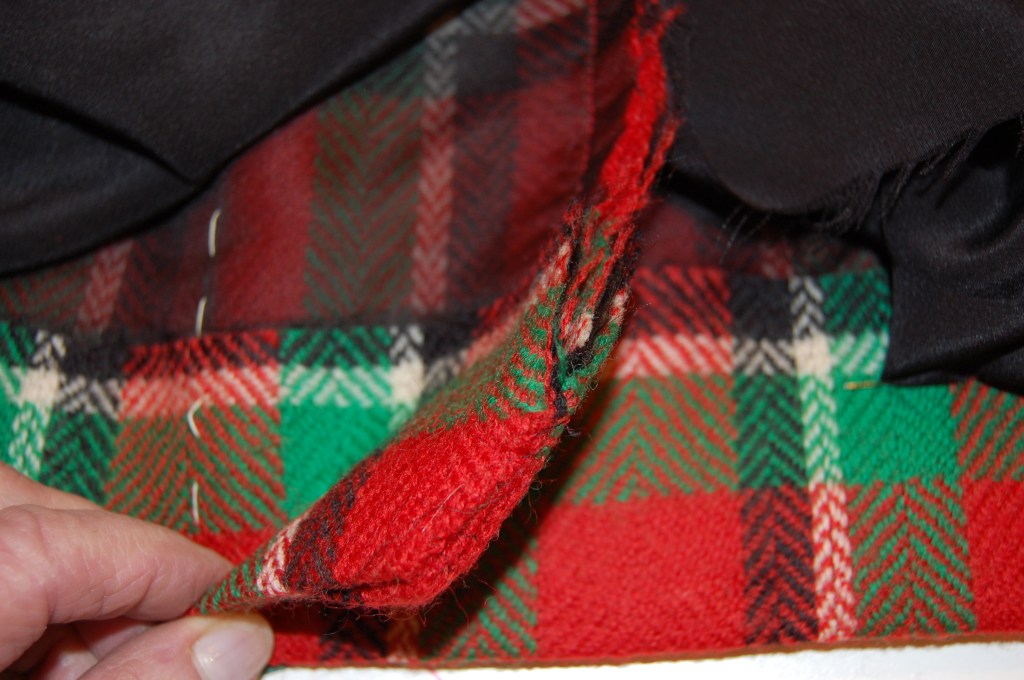
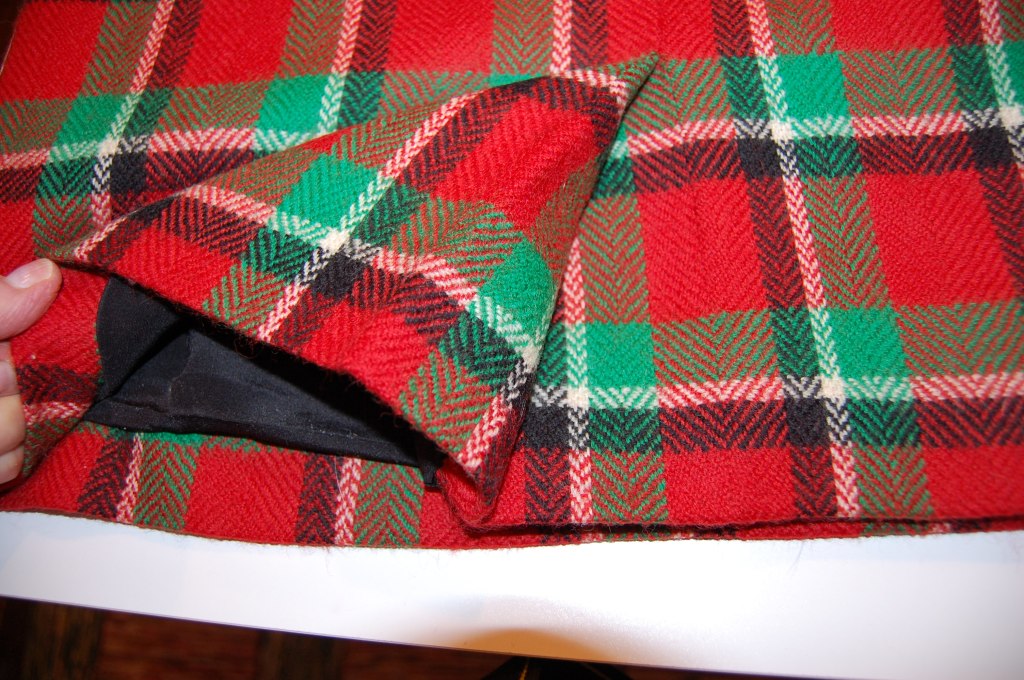
I loved that fact that this type of kick pleat made the perfect setting for a lapped zipper, shown below.
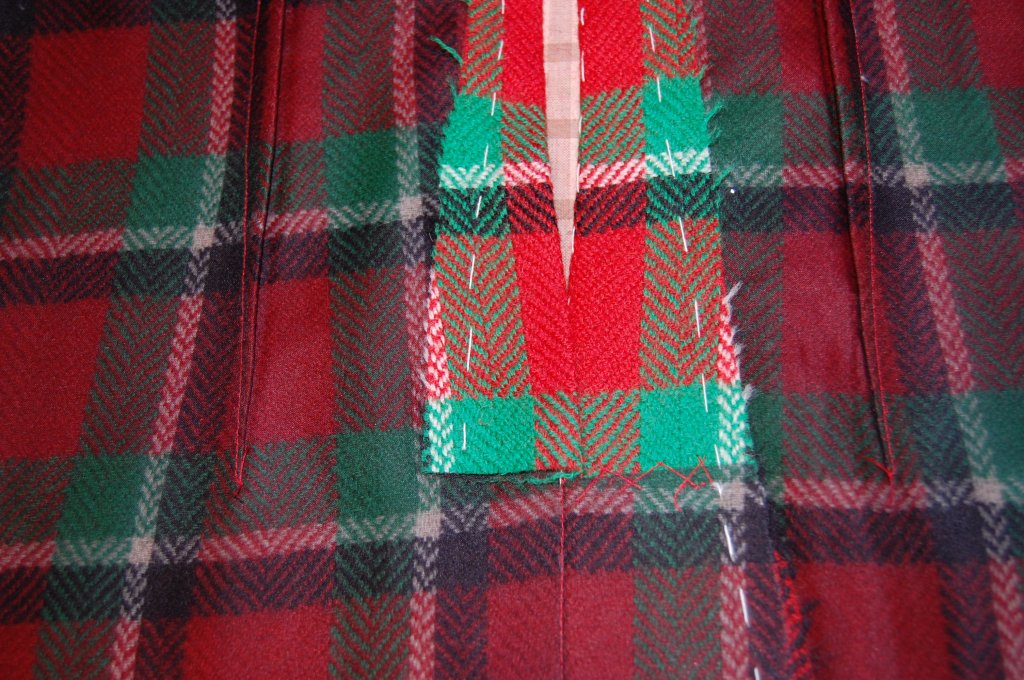
You will notice this dress has two shaping darts on either side of the front panel, in addition to the bust darts. The back has one shoulder dart and one shaping dart on either side.
All these darts make for such a lovely fit. In addition, I used a trick I have learned from Susan Khalje. Instead of sewing the bust dart into the side seam, I allowed it to float free, stitching the seam above and below the dart. I did this for both the fashion fabric and the lining. Using this method provides more ease to the bust.
I did lower the neckline by about ½ inch, and I cut the shoulders in by about an inch on either side. These changes just seemed to look better on me, as determined by my muslin (toile).
I lined the dress in black silk crepe de chine. (I find almost all my lining silk at Emma One Sock.) When it came to the kick pleat, I found that a slanted seam below the end of the zipper was necessary to divide the lining between the two sides of the kick pleat.
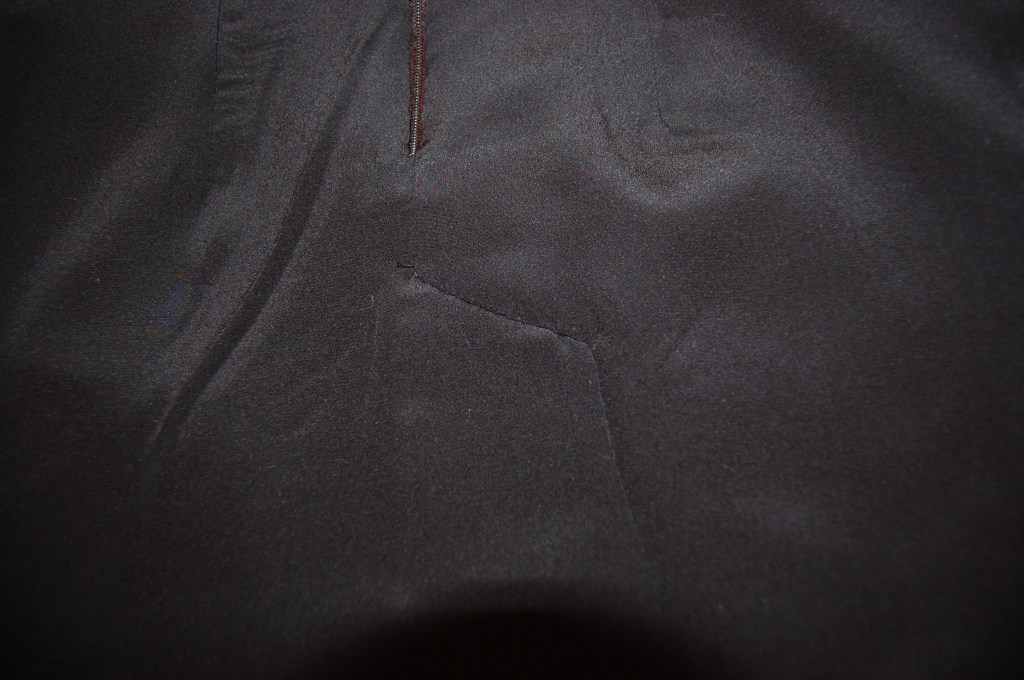
I have no idea how to explain what I did to finish the lining in this area. Just know that whatever I did – worked! I ended up with no lumps and no restriction on the functionality of the pleat.


This dress was such a fun project. I loved working with such a beautiful wool and such a beautiful pattern. There will be more such sheath dresses in my future.
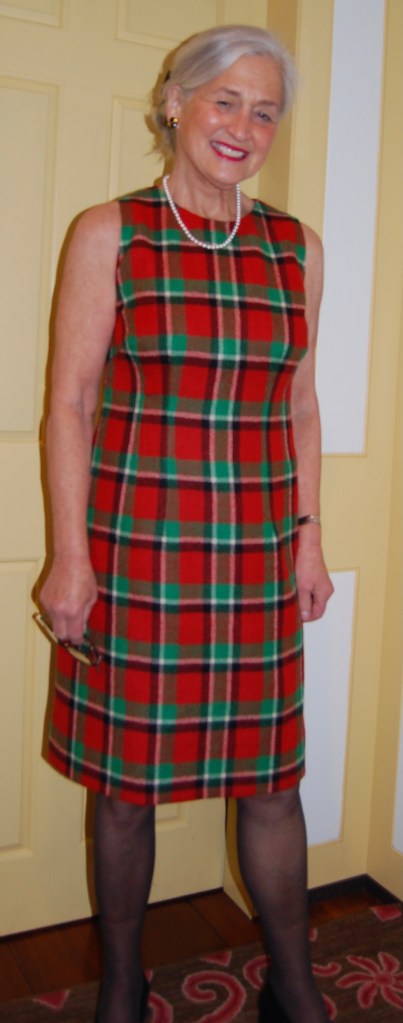
So now, how about you? Have you started the new year in Vogue? I hope so!

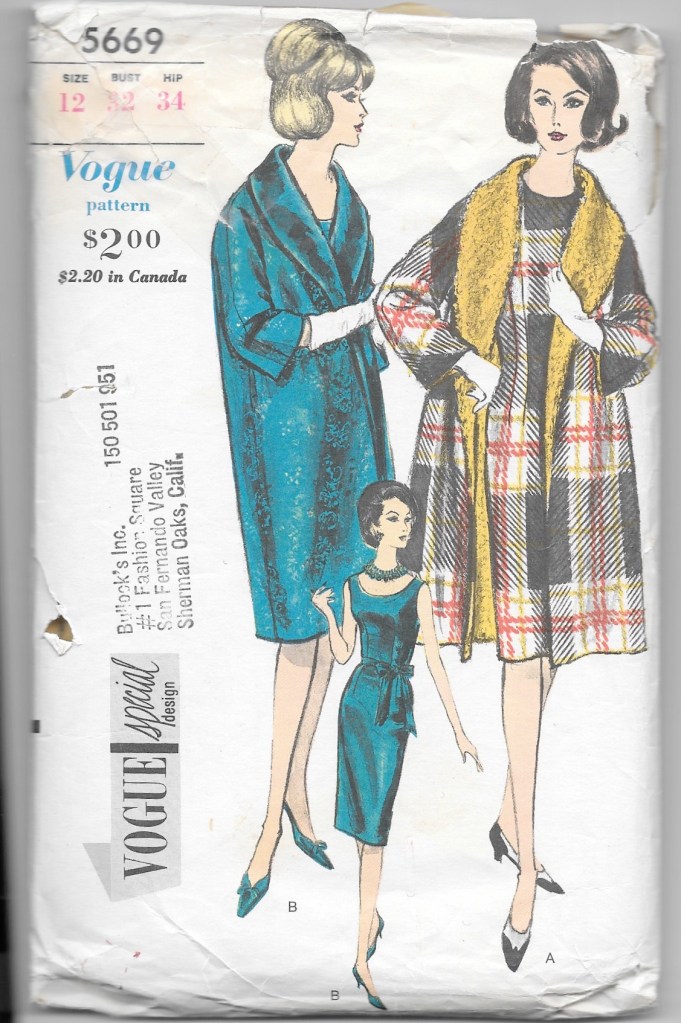
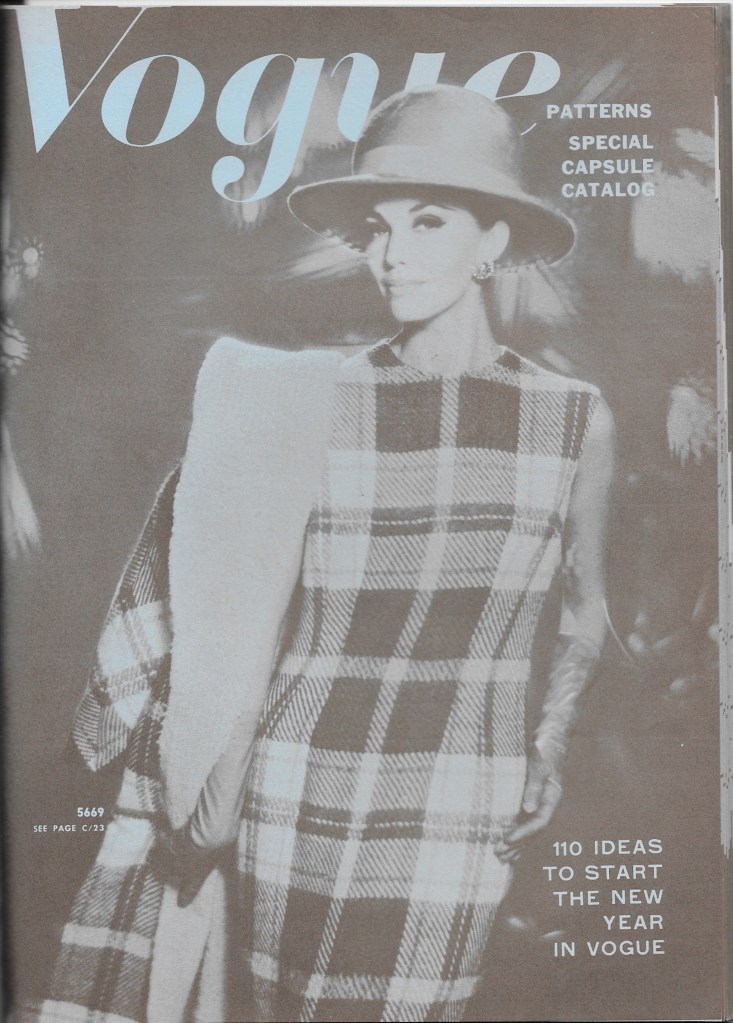
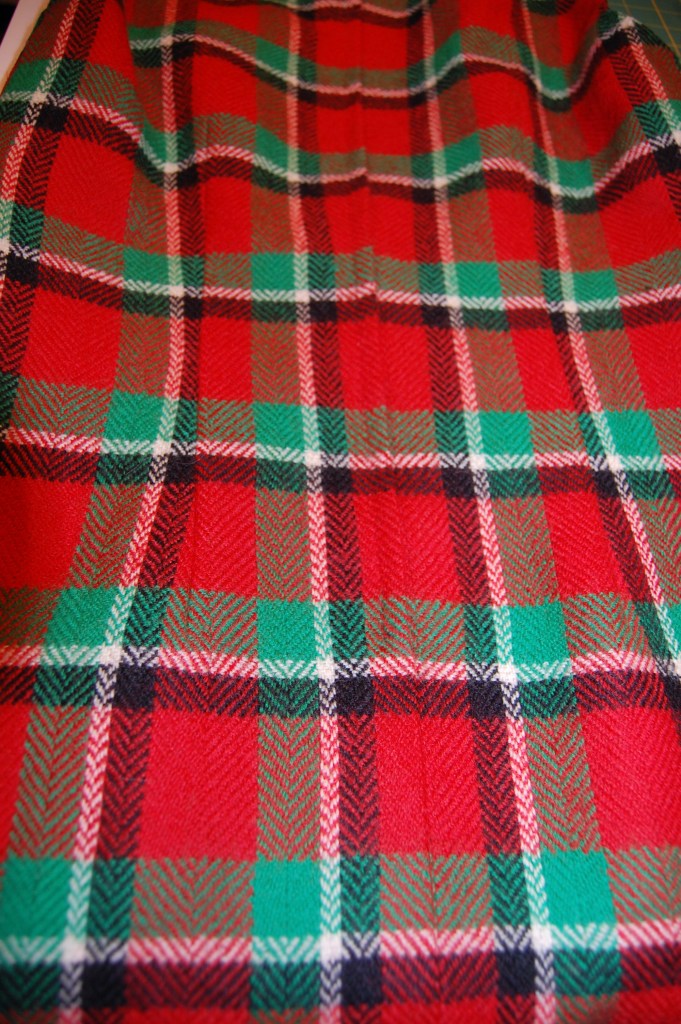
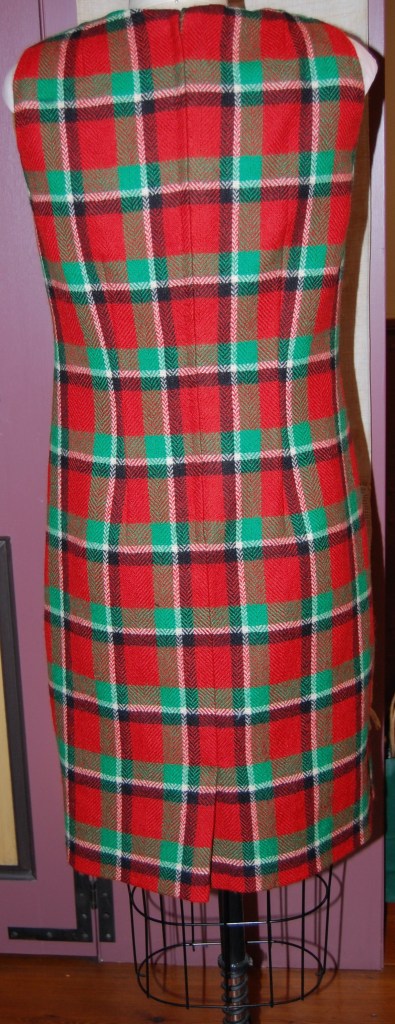
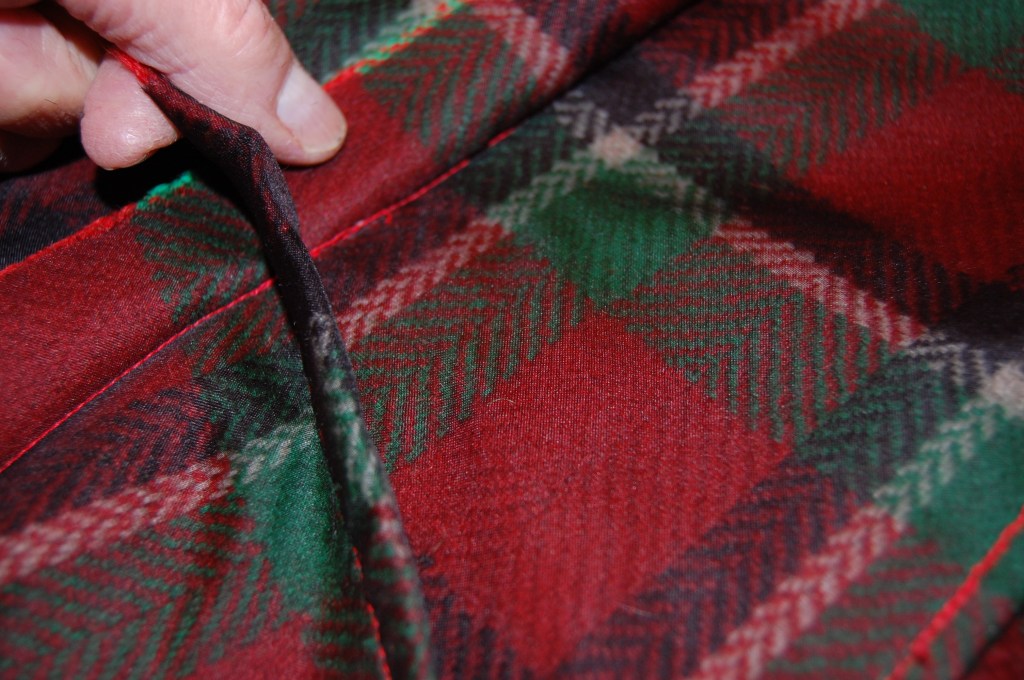
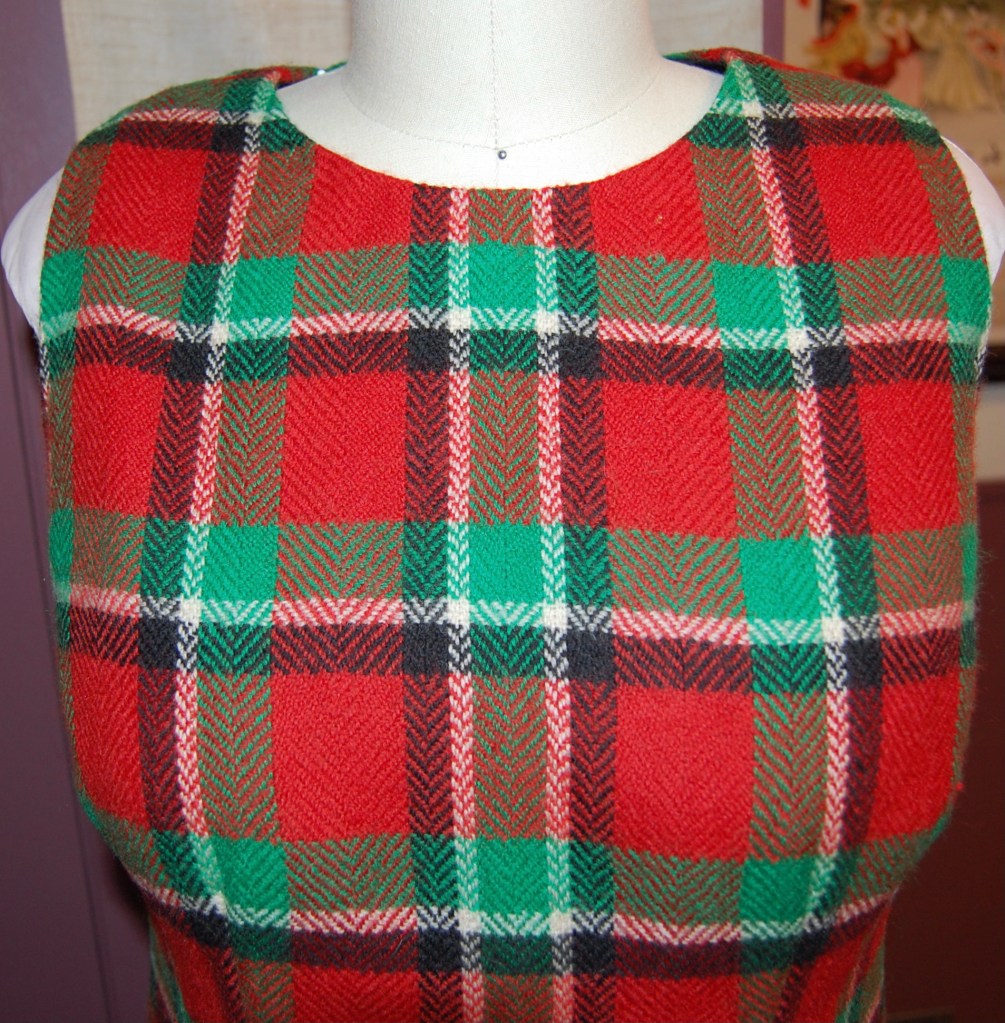
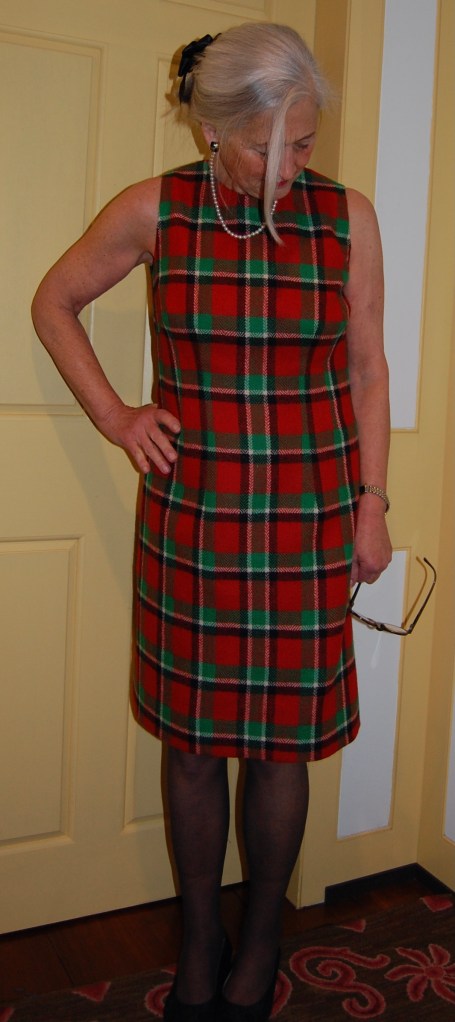

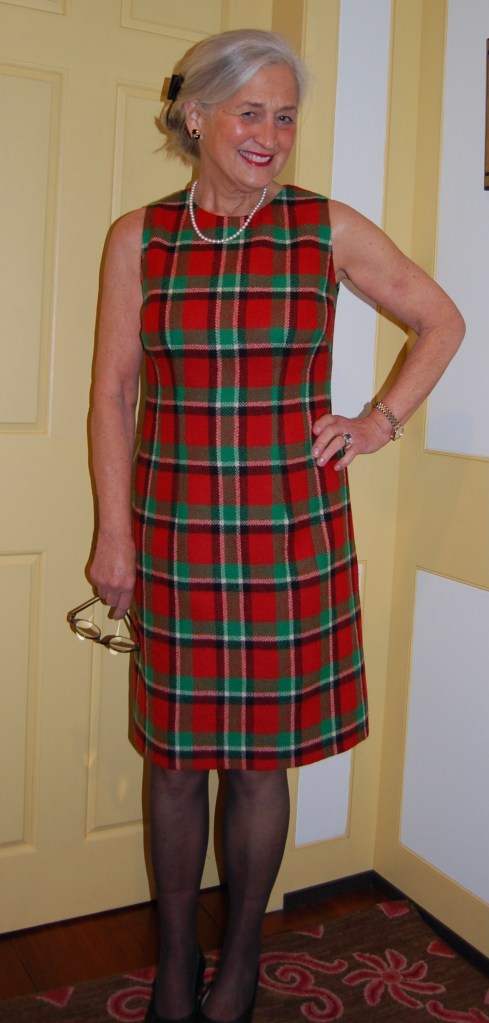

Beautiful sewing. It looks great.
Thank you, Beth!
You are a genius ❗️
Well, I’m flattered you think so, Peggy. Honestly, I’m just using knowledge I’ve picked up from so many talented fellow dressmakers and printed sources.
I love the pattern- the cut-in arm is so flattering and unusual. Also, thank you for taking the time to do detailed descriptions and pictures of construction- it makes your blog special and I get excited when I see one come into my email inbox.
Thank you so much, Suzanne. Your comment makes me feel wonderful!
Karen, What a wonderful dress you have made. A real kick pleat. Now that is a joy to see. Whenever I look at ready-made clothes today, I am so dismayed at the lack of quality construction details such as your clothes all present. Even jackets that cost $300+. Does this bother you as much as it does me? It does make me thankful that I lived at a time when most women’s clothes were as well constructed as yours are. And, I’m referring to clothes that one could buy in almost any department store.
Looking forward to seeing that black jacket. Black velvet would be gorgeous.
I so agree, Karen! Even very expensive clothing often has what I call “shortcuts” in their construction. That is really one of the joys of sewing – knowing that I can wear clothing with special details in them. Hmmm – I had not thought of velvet!
Beautiful dress, wonderful use of 1.25 yards, and looks lovely on you.
Thank you so much, Joan. I feel so fortunate to have found this fabric!
I don’t sew at all but am mesmerized reading your description of the process. And you are beautiful in your snazzy new dress! Now, to be able to go somewhere……
Xoxo Peggy
Thank you, dear Peggy! I just love that you follow my blog!
This is exquisite. First time reading your blog, though I’ve subscribed for a while. Appreciate your thorough description of your process. You’ve inspired me to ‘sheath’ that 1.5 yards of lipstick red silk crepe de chine I’ve had in my stash for 23 years! And OH! The organza underlining as guide for the plaid placement has me reeling! I just struggled with a large floral brocade matching situation that your trick would have solved! Stay safe, Dear Lady.
Thank you, Wynne. Lipstick red silk crepe de chine sounds positively luscious! Go for it!
The way the darts shape the plaid is so flattering! Perfection.
Thank you so much! It’s such a lovely pattern – I feel fortunate to have it available to me!
Karen, your dress is just lovely, and you matched those plaids perfectly!
Thank you, Arleen. Lots of basting helped me match those plaids…
So very pretty and so are you. Now if we could just go some place to wear the things we sew!
Thank you, Betty! Yes, I agree – how much I am looking forward to going somewhere in a nice, pretty dress – whenever that might be.
I love following your blog. Even though I only make menswear your approach to sewing is inspirational, and I learn so much from your deep dives. This dress is a wonder. How you ever got it out of 1.5 yards of cloth seems like a miracle to me!
Thank you so much, MainelyDad! I’m so happy to have you as a follower. As far as the scant fabric available, it helps that I’m on the “smaller size” of things! And with using couture construction, I did not need to cut facings from the fashion fabric, which saves quite a bit.
Such a beautiful use of a wonderful piece of vintage wool. And the darts give such a flattering amount of shaping without distorting the plaid.
Thanks so much! I was initially worried the 4 darts in the front might make it too curvy, but they seemed to be just perfect.
So interesting to understand your thinking behind the placement of the plaid – thank you for sharing the photos. Your efforts really paid off because the dress looks stunning. Looking forward to seeing the coordinating jacket.
Thank you, Jane. I’m excited to make a jacket for it, but I’m not sure what the timing will be on that yet…
Wow, great job! I love the center plait, thats a genius thing. I wish I could find plaids like that.
I wonder, the fabric seems to be pretty warm, how does it pair for you with bare arms?
You are correct – the fabric is warm – and that’s why I need to make a jacket to wear with it! Thanks so much for your comment!
One amazing accomplishment! Lapped zipper is perfect. I couldn’t
praise it enough!
Thank you so much, Peggy! I do love a lapped zipper…
Gorgeous work Karen! I love it!
Jacqueline
Thank you, Jacqueline. I still think about your gorgeous Blackwatch tartan wool sheath dress!
Lovely dress, and thank you for sharing the bust dart tip – I’ll make sure to do this in future.
I think you will like the results!
Is there an archive of old Vogue Pattern Magazines? I know there’s a Wiki to research vintage patterns. I love the whole concept, the Forstman fabric and the classy Vogue pattern. The research and care in your work is it what it takes to step out in style!
If there is an archive, I do not know about it. I have collected many, many issues of Vogue Pattern Magazine from the 1950s, ’60’s and ’70s, and they are a treasure trove of information. I just think it is so rewarding to know something about the patterns and fabric I am using, and I love the detective work that goes into it. Thank you for your lovely comment.
That fabric hid all those years waiting for your fine touch, and what a fine job you have done! I keep coming back to look at details, especially the layout.
Thank you, Mery. It’s so funny, I always get a little twinge when I cut into a vintage piece of wool, as if it is sacrilege to disturb something with so much history to it. I try to reassure myself that I’m just helping it reach its intended goal!
This is so impressive! Plaid has to be one of the most challenging styles and it is perfect here.Thank you for sharing the tip about the bust dart. As always it makes so much sense once it has been recommended.
Thank you Cheryl. I have used this bust dart tip frequently, and it is amazing how well it works. Sewing really is a common sense endeavor, isn’t it?
Karen,
Indeed the stars aligned for this dress! It’s gorgeous and chic. Thank you for the tip on sewing the bust dart, and for sharing your process! Patience + practice = success!
Thanks, Sarah! As you know so well, patience is a plus with fashion sewing!
Well, it is just stunning! I love the thoughtful pattern placement, especially the center front. Another timeless treasure to add to your exquisite wardrobe.
Thank you so much. The wool made it easy to balance that front so well!
Beautiful quality dress! Have you considered a green jacket rather than black? Or cream. Look at the inspirational wools at this UK site https://www.fabworks.co.uk/
DKUK
Thank you so much for your input. I had thought about green, but do not want to make this too Christmasy… I may line a potential jacket in green, however!
Dear Karen,
I agree with the others, your dress is stunning! It fits my definition of couture sewing and I am in awe. Reading your blog is a master class for garment construction! I can tell you love what you do… there are so many times when sewing presents a puzzle to solve and following you on your journey into, through, and out of the maze is a delight! I’m so glad I found you! xo, Nancy
Thanks so much, Nancy. I so appreciate hearing this – and I do love fashion sewing! I would say it keeps me out of mischief, but that’s not really true. Just yesterday, despite my best intentions, I purchased two new silks…! So lovely to hear from you!
Such an adorable dress! Really appreciate your meticulous finishing details. I am always disappointed when I see a plaid handled poorly in terms of matching seams, darts etc. Learned new tips from you re. The bust dart and starting the pattern layout with a plaid (probably other patterns too) from the hem. Thank you sew much. I haven’t made many clothes for a while now but am starting to gather my mojo reading blogs like yours.
There are lots of considerations when sewing with plaids, that’s for sure! I cringe when I see RTW plaids that are not matched correctly. But I think dressmakers pick up on those details when many people do not.
What an absolute stunner! And that tip about the mirrored center line blew my mind– I would never have thought to look for that. Fingers crossed I can get my hands on some top-notch plaid one day, though I know it’s a little ways off yet before I’d feel confident enough to cut into it. Thanks so much for sharing this amazing project!
Thank you, Meg! I have to say in all my years of sewing, I have never found another uneven plaid with this orientation. It certainly was wonderful to sew with – beautiful quality, saturated colors and, of course, perfectly balanced. It was so nice to hear from you about this project.